中英文论文对照格式
传感器技术论文中英文对照资料外文翻译文献
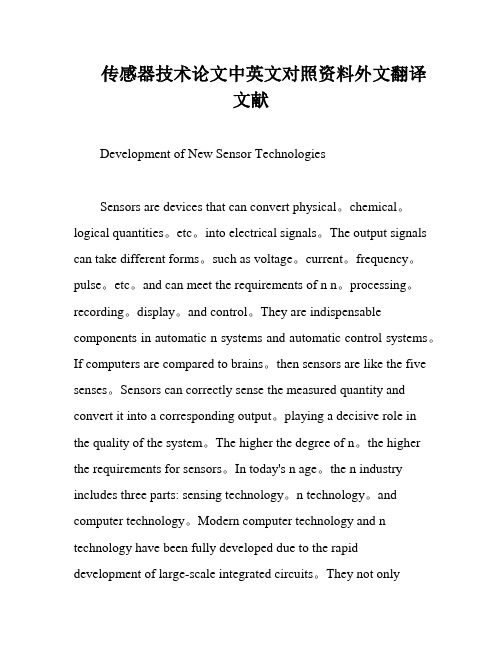
传感器技术论文中英文对照资料外文翻译文献Development of New Sensor TechnologiesSensors are devices that can convert physical。
chemical。
logical quantities。
etc。
into electrical signals。
The output signals can take different forms。
such as voltage。
current。
frequency。
pulse。
etc。
and can meet the requirements of n n。
processing。
recording。
display。
and control。
They are indispensable components in automatic n systems and automatic control systems。
If computers are compared to brains。
then sensors are like the five senses。
Sensors can correctly sense the measured quantity and convert it into a corresponding output。
playing a decisive role in the quality of the system。
The higher the degree of n。
the higher the requirements for sensors。
In today's n age。
the n industry includes three parts: sensing technology。
n technology。
and computer technology。
英文论文标准格式范文
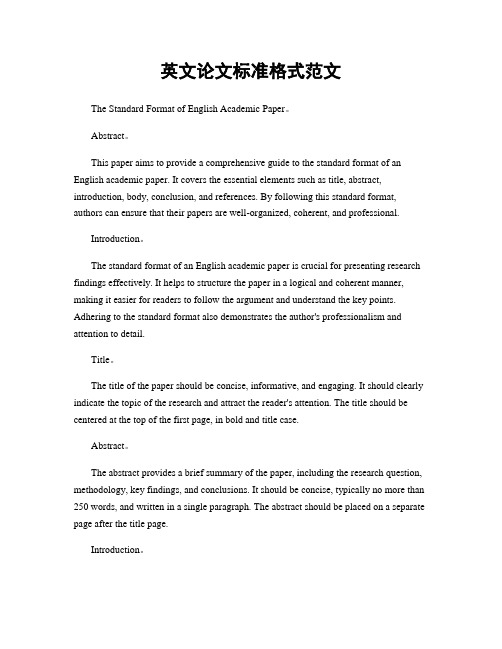
英文论文标准格式范文The Standard Format of English Academic Paper。
Abstract。
This paper aims to provide a comprehensive guide to the standard format of an English academic paper. It covers the essential elements such as title, abstract, introduction, body, conclusion, and references. By following this standard format, authors can ensure that their papers are well-organized, coherent, and professional.Introduction。
The standard format of an English academic paper is crucial for presenting research findings effectively. It helps to structure the paper in a logical and coherent manner, making it easier for readers to follow the argument and understand the key points. Adhering to the standard format also demonstrates the author's professionalism and attention to detail.Title。
The title of the paper should be concise, informative, and engaging. It should clearly indicate the topic of the research and attract the reader's attention. The title should be centered at the top of the first page, in bold and title case.Abstract。
英文学术论文翻译-中英文对照(三)
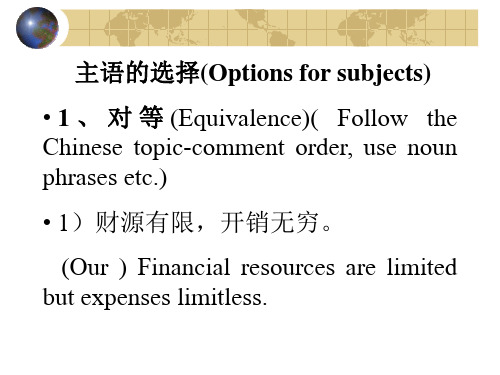
2)游中国当然是必游长城。 A must for all the tourists to China is to visit the Great Wall. 3)中国的国民意识是把追求家庭幸福提到个 人幸福之上,而美国人似乎与此相反。 In the Chinese ideology, the pursuit of family happiness has been elevated to the place before personal happiness, while for the Americans the order seems to be the reverse.
2-2 By means of inference (decide SV based on thorough interpretation)
• 1)发现错误,要改正错误。 Wrongs must be righted when they are discovered.
2)我们的各项工作都取得了一些成就,但不 能因此而骄傲自满。 We have made some achievements in various fields of our work but we must not get conceited and arrogant. 3)我们的自然科学比较落后,要努力向外国 学习。 In natural science, we are rather backward and we should make a special effort to learn from foreign countries.
Customers from various countries and regions are welcome to establish and develop business contacts with us. China’s first atomic blast in October, 1964 was a great shock to the rest of the world. Everything taken into consideration, her proposal seems more practicable. A special fund will be set aside to support these products which fall within five hi-tech spheres— new materials mechatronics, electronic information, biotechnology, new energy resources and energy conservation. It is a general opinion that to simplify formalities and to enhance efficiency are more important than to give preferential economical treatment to enterprises.
大学生论文模板之中英文格式要求

中文题目(注:应准确简洁地反映稿件的主要内容和特色。
不要使用缩略语,也不要出现诸如“……的研究”或“……的探索”等模糊字样)全部作者姓名(注:姓名间用逗号隔开,并在通讯联系人的姓名右上方标注“*”号,如:作者一1,作者二1,2,作者三1,*)(1.第一单位中文标准全称,省名市名邮编;2.第二单位中文标准全称,省名市名邮编)摘要:(1)摘要应为独立的小短文,以第三人称撰写。
(2)摘要中需展示出所报道工作的创新和重要之处,主要从实验目的(通常包括研究背景、研究或实验目的、研究或实验范围)、方法(介绍研究或实验过程、说明所用方法)、结果(列出主要论点和重要数据)和最终结论(研究或实验结果的理论价值或应用价值)四个方面描述,四要素缺一不可,但不要直接标注“目的”“方法”等字样;特别要强调的是摘要内容均应包含在正文中。
(3)在摘要中不用非公知公用的符号和术语;不用引文,除非该论文证实或否定了他人已发表的论文;缩略语、略称、代号在首次出现时必须加以说明;不用图、表、化学结构。
(4)中文摘要需250~300字。
关键词:关键词1;关键词2;关键词3;关键词4 (3~8个,不使用缩略语)Title in English(注:与中文题名含义一致;除了专有名词及句首词外的其他单词均为小写) Author11, Author21,2, Author31 , Corresponding author1,2,*(注:姓全大写,名首字母大写)(1.第一单位英文标准全称, 市名邮编, China; 2. 第二单位英文标准全称, 市名邮编, China)Abstract: (1) 英文摘要应符合英文语法,提倡用短句表述。
(2) 本刊现已被美国《化学文摘》(CA)、美国《医学索引》(IM)、美国《剑桥科学文摘》(CSA)、英国《分析化学文摘》(AA)等检索系统收录,为了方便国际交流和扩大国际影响,增大文章被国际同行引用的机会,作者需撰写内容详细的英文摘要(包括较为详细的实验方法),不必与中文摘要一一对应,一般需200~300个单词。
统计学论文中英文对照资料外文翻译文献

中英文对照资料外文翻译文献Policies for Development of Iron and Steel IndustryThe iron and steel industry is an important basic industry of the national economy, a supporting industry for realizing the industrialization and an intensive industry in technologies, capital, resources and energy, and its development requires a comprehensive balancing of all kinds of external conditions. China is a big developing country with a comparatively big demand of iron and steel in the economic development for a long time to go. China's production capacity of iron and steel has ranked the first place in the world for many years. However, there is a large gap in terms of the technological level and material consumption of the iron and steel industry compared with the international advanced level, so the focus of development for the future shall be put on technical upgrading and structural adjustment. In order to enhance the whole technical level of the iron and steel industry, promote the structural adjustment, improve the industrial layout, develop a recycling economy, lower the consumption of materials and energy, pay attention to the environmental protection, raise the comprehensive competitive capacity of enterprises, realize the industrial upgrading, and develop the iron and steel industry into an industry with international competitive capacity that may basically satisfy the demand of the national economy and social development in terms of quantity, quality and varieties, we have formulated the policies for development of the iron and steel industry according to the relevant laws and regulations and the domestic and internationalsituations that the iron and steel industry faces so as to guide the sound development of the iron and steel industry.Chapter I Aim of the PolicyAccording to the requirement of our country's economic and social development and the situation of resources, energy and environmental protection, the production capacity of iron and steel shall maintain at a reasonable scale, which may be specifically resolved in the relevant planning. The comprehensive competitive capacity of iron and steel industry may reach to the international advanced level so that China may become a large country in iron and steel production and a great power country in world-wide competitive.By the year 2010, through the means of structural adjustment of products, the proportion of good iron and steel products shall be elevated considerably, the majority of products shall be basically satisfied the development requirements of most industries in the national economy such as construction, machinery, chemical industry, auto-mobiles, household appliances, vessels, traffic, railway, military industry and new industries.We may elevate the industrial concentration by means of organizational and structural adjustment of the iron and steel industry, and expand the scale of those backbone enterprise groups with comparative advantages by means of amalgamate and reorganization . By 2010, the number of iron and steel smelting enterprises shall be considerably reduced and the production capacity of the iron and the output of steel enterprise groups that rank top 10 in the domestic market shall be reached to 50 % and above of the national total production capacity; by 2020, the proportion shall bereached to 70% and above.By means of layout adjustment of the iron and steel industry, by 2010, the unreasonable layout shall be improved; by 2020, a comparatively reasonable industrial layout that complies with the supply of resources and energy, allocation of traffic and transportation, supply and demand of the market and environmental capacity shall be formed.According to the concept of sustainable development and recycling economy, we should elevate the comprehensive level of environmental protection and resource utilization, and should save energy and lower consumption. We should elevate the comprehensive utilization capacity of waste gases, water and rubbishes to the largest possible extent, strive for the goal of realizing "zero discharge" and establish iron and steel factories of the recycling type. The iron and steel enterprisesmust develop the business of generating power by using reclaimed heat and energy. An iron and steel associated enterprise with the production scale of more than 5 million tons shall strive for the goal of having more than enough power to support itself and providing the surplus to outsiders. By 2005, the comprehensive energy consumption for each ton of steel shall be lowered to 0.76 ton of standard coal, the comparable energy consumption for each ton of iron shall be lowered to 0.70 ton of standard coal and the water consumption for each ton of steel shall be lowered to less than 12 tons in the whole industry; by 2010, the corresponding index shall be lowered to 0.73 ton of standard coal, 0. 685 ton of standard coal and less than 8 tons of water, respectively; by 2020, the corresponding index shall be lowered to 0.7 ton of standard coal, 0.64 ton of standard coal and less than 6 tons of water, respectively. That is, in the coming 10 years, the iron and steel industry shall, on the precondition that the total consumption of water resources decreases and the total energy consumption increases by a small margin, and realize a proper development in total quantity.Before the end of 2005, all the wastes as discharged by iron and steel enterprisesshall have been met the standards of the state and local provisions, and the total discharge volume of major wastes shall have been met the controlling index as verified by the local environmental department.Chapter II Industrial Development PlanningThe state shall guide the iron and steel industry to develop in a sound, sustainable and harmonious manner through the development policies and the mid- and long-term development planning of the iron and steel industry. The mid- and long-term development planning of the iron and steel industry shall be formulated by the National Development and Reform Commission (hereinafter referred to the NDRC) in collaboration with other relevant departments.An enterprise group with a production capacity of more than 5 million tons in 2003 may, according to the state mid- and long-term development planning of the iron and steel industry and the overall planning of the city where it is located, formulate the planning of its own, which shall be implemented upon the approval of the State Council or the NDRC after making necessary cohesion and balancing efforts. The specific construction projects of the planning shall not be required to be subject to the examination and approval or verification of the NDRC, but shall be organized and implemented by the enterprise itself after such formalities for examination and approval of land, environmental protection, security and credit have been handled, and shall be reported to the NDRC for archival filing according to the relevant provisions.The development of any other iron and steel enterprise shall also meet the requirements of the development policies and mid- and long-term development planning of the iron and steel industry.Chapter III Adjustment of Industrial LayoutAdjustment of Industrial LayoutArticle 10For the adjustment of industrial layout, we should take such conditions as mineral resources, energy, water resources, traffic and transportation, environmental capacity, market allocation and overseas resources into account in a comprehensive manner. For the layout adjustment of the iron and steel industry, we shall not establish any new iron and steel associated enterprise alone, independent iron-smelting or steel-smelting factory as a general principle. It's not encouraged to establish any independent steel-rolling factory. We should, on the basis of those established enterprises that meet relevant conditions and in combination with merger and relocation, carry out reform and expansion in those regions with such comparative advantages as water resources, raw materials, transportation and market consumption. We should combine new increase of production capacity with elimination of backward production capacity and shall not, as a general rule, substantially expand the production capacity.In the important regions of environmental protection, the regions in serious short of water, the urban district of big cities, the iron and steel smelting and production capacity shall not be expanded any more. Those enterprises established within the districts shall, in combination of the adjustment of organizational structure, equipment structure and product structure, cut production and move to other places so as to meet the requirements of environmental protection and resource economization.Thinking over the bulk ores, energy, resources, water resources, transportation condition and the domestic and overseas market the large-scale iron and steel enterprises shall be mainly located along the coastal areas. The iron and steel enterprises in inland regions shall, in combination with the local market and bulk ore resources, determine their production according to the mines available, and shallregard the sustainable production as the main factor for consideration other than strive for any expansion of production scale.There are abundant resources of iron mines in the Anshan-Benxi region in north-east China, which is near the production bases of coal and has a certain condition of water resources. According to the development strategy of vitalizing the old north-east industrial base, the iron and steel enterprises in this region shall, according to the requirements of associated reorganization and establishing a top-quality production base, eliminate the backward production capacity so as to build up a large enterprise group with international competitive capacity. .As the region of North China is in short of water resources and the production capacity and level thereof is low and excessive, we should, according to the ecological requirements of environmental protection, put the focus on structural adjustment, carry out merger and reorganization, strictly control the continuous over-increase of production factories and expansion of production capacity. We should relocate the Capital Steel Corporation and the reorganize it with the iron and steel industry of Hebei Province.The steel material market in North China has a big potential. However, the layout of iron and steel enterprises thereof are over-intensified and thus, the large backbone enterprises with comparative advantages within this region may, in combination of the adjustment of organizational structure and product structure, elevate their production concentration and international competitive capacity .As the central-southern region has abundant water resources andconvenient water transportation, the south-east coastal regions shall make full use of the advantage of deep waters and good harbors to build up large iron and steel associated enterprises in combination with the industrial reorganization and the relocation of urban steel factories.There are abundant water resources in the west-south regions, and in thePanzhihua-Xichang area has a large storage capacity of iron mines and coal resources but with inconvenient transportation. The key backbone enterprises existed shall improve their equipments level, adjust the variety structure, develop high-value-added products, determine the production capacity according to the sustainable supplying capacity of bulk ores rather than blindly pursue the increase of quantity.As the west-north region is in short of bulk iron ores and water resources, the backbone enterprises existed shall put the focus on satisfying the requirement of local regional economic development other than pursue the expansion of production scale, and shall make good use of the mineral resources in neighboring countries actively.政策发展钢铁工业钢铁工业是国民经济的重要基础产业,是实现工业化和技术,资本密集型产业的支撑产业,资源和能源,以及它的发展需要各种外部条件的综合平衡。
(论文中英文摘要格式)
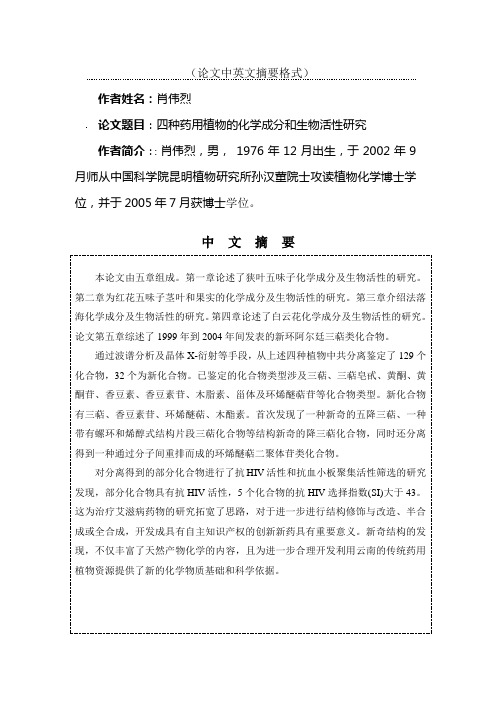
(论文中英文摘要格式)作者姓名:肖伟烈论文题目:四种药用植物的化学成分和生物活性研究作者简介::肖伟烈,男, 1976年12月出生,于2002年9月师从中国科学院昆明植物研究所孙汉董院士攻读植物化学博士学位,并于2005年7月获博士学位。
中文摘要本论文由五章组成。
第一章论述了狭叶五味子化学成分及生物活性的研究。
第二章为红花五味子茎叶和果实的化学成分及生物活性的研究。
第三章介绍法落海化学成分及生物活性的研究。
第四章论述了白云花化学成分及生物活性的研究。
论文第五章综述了1999年到2004年间发表的新环阿尔廷三萜类化合物。
通过波谱分析及晶体X-衍射等手段,从上述四种植物中共分离鉴定了129个化合物,32个为新化合物。
已鉴定的化合物类型涉及三萜、三萜皂甙、黄酮、黄酮苷、香豆素、香豆素苷、木脂素、甾体及环烯醚萜苷等化合物类型。
新化合物有三萜、香豆素苷、环烯醚萜、木酯素。
首次发现了一种新奇的五降三萜、一种带有螺环和烯醇式结构片段三萜化合物等结构新奇的降三萜化合物,同时还分离得到一种通过分子间重排而成的环烯醚萜二聚体苷类化合物。
对分离得到的部分化合物进行了抗HIV活性和抗血小板聚集活性筛选的研究发现,部分化合物具有抗HIV活性,5个化合物的抗HIV选择指数(SI)大于43。
这为治疗艾滋病药物的研究拓宽了思路,对于进一步进行结构修饰与改造、半合成或全合成,开发成具有自主知识产权的创新新药具有重要意义。
新奇结构的发现,不仅丰富了天然产物化学的内容,且为进一步合理开发利用云南的传统药用植物资源提供了新的化学物质基础和科学依据。
1 2 3 45 6 7 89 10 11 12图-1 结构新奇的化合物第一章狭叶五味子的化学成分和生物活性研究狭叶五味子(Schisandra lancifolia (Rehd. et Wils.) A. C. Smith)。
全株药用,味微苦、涩、性温,有止血接骨、去淤消肿之功效,用于跌打损伤、骨折、外伤出血等症。
英文论文(外文文献)翻译成中文的格式与方法
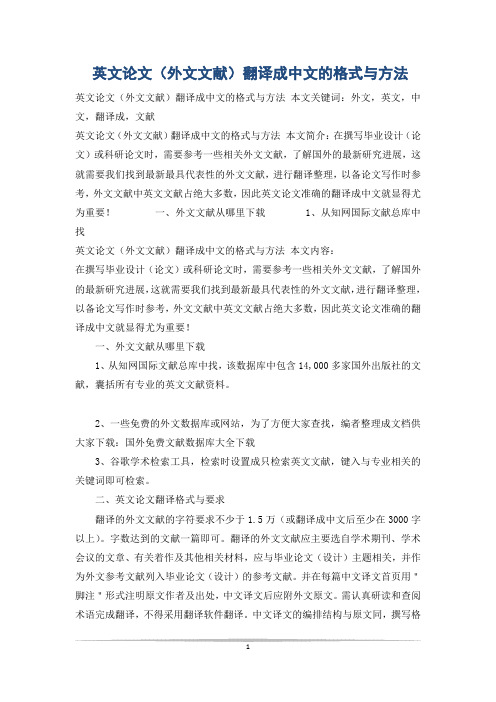
英文论文(外文文献)翻译成中文的格式与方法英文论文(外文文献)翻译成中文的格式与方法本文关键词:外文,英文,中文,翻译成,文献英文论文(外文文献)翻译成中文的格式与方法本文简介:在撰写毕业设计(论文)或科研论文时,需要参考一些相关外文文献,了解国外的最新研究进展,这就需要我们找到最新最具代表性的外文文献,进行翻译整理,以备论文写作时参考,外文文献中英文文献占绝大多数,因此英文论文准确的翻译成中文就显得尤为重要!一、外文文献从哪里下载1、从知网国际文献总库中找英文论文(外文文献)翻译成中文的格式与方法本文内容:在撰写毕业设计(论文)或科研论文时,需要参考一些相关外文文献,了解国外的最新研究进展,这就需要我们找到最新最具代表性的外文文献,进行翻译整理,以备论文写作时参考,外文文献中英文文献占绝大多数,因此英文论文准确的翻译成中文就显得尤为重要!一、外文文献从哪里下载1、从知网国际文献总库中找,该数据库中包含14,000多家国外出版社的文献,囊括所有专业的英文文献资料。
2、一些免费的外文数据库或网站,为了方便大家查找,编者整理成文档供大家下载:国外免费文献数据库大全下载3、谷歌学术检索工具,检索时设置成只检索英文文献,键入与专业相关的关键词即可检索。
二、英文论文翻译格式与要求翻译的外文文献的字符要求不少于1.5万(或翻译成中文后至少在3000字以上)。
字数达到的文献一篇即可。
翻译的外文文献应主要选自学术期刊、学术会议的文章、有关着作及其他相关材料,应与毕业论文(设计)主题相关,并作为外文参考文献列入毕业论文(设计)的参考文献。
并在每篇中文译文首页用"脚注"形式注明原文作者及出处,中文译文后应附外文原文。
需认真研读和查阅术语完成翻译,不得采用翻译软件翻译。
中文译文的编排结构与原文同,撰写格式参照毕业论文的格式要求。
参考文献不必翻译,直接使用原文的(字体,字号,标点符号等与毕业论文中的参考文献要求同),参考文献的序号应标注在译文中相应的地方。
格式2:硕士论文中英文摘要格式
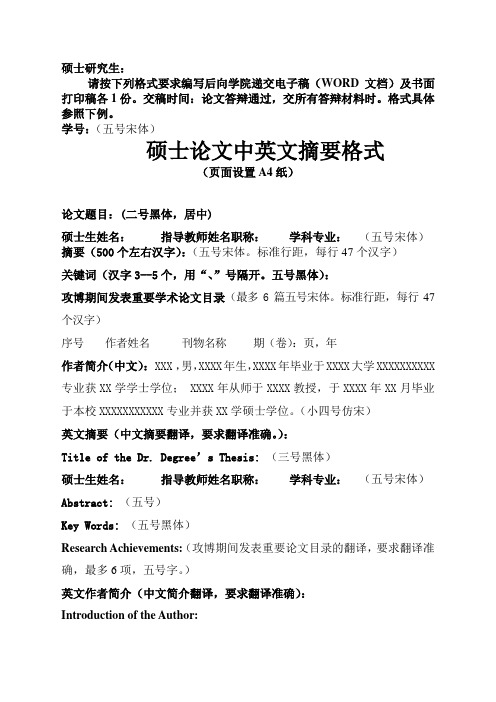
硕士研究生:请按下列格式要求编写后向学院递交电子稿(WORD文档)及书面打印稿各1份。
交稿时间:论文答辩通过,交所有答辩材料时。
格式具体参照下例。
学号:(五号宋体)硕士论文中英文摘要格式(页面设置A4纸)论文题目:(二号黑体,居中)硕士生姓名:指导教师姓名职称:学科专业:(五号宋体)摘要(500个左右汉字):(五号宋体。
标准行距,每行47个汉字)关键词(汉字3--5个,用“、”号隔开。
五号黑体):攻博期间发表重要学术论文目录(最多6篇五号宋体。
标准行距,每行47个汉字)序号作者姓名刊物名称期(卷):页,年作者简介(中文): XXX ,男,XXXX年生,XXXX年毕业于XXXX大学XXXXXXXXXX专业获XX学学士学位; XXXX年从师于XXXX教授,于XXXX年XX月毕业于本校XXXXXXXXXXX专业并获XX学硕士学位。
(小四号仿宋)英文摘要(中文摘要翻译,要求翻译准确。
):Title of the Dr. Degree’s Thesis:(三号黑体)硕士生姓名:指导教师姓名职称:学科专业:(五号宋体)Abstract: (五号)Key Words:(五号黑体)Research Achievements:(攻博期间发表重要论文目录的翻译,要求翻译准确,最多6项,五号字。
)英文作者简介(中文简介翻译,要求翻译准确):Introduction of the Author:例:学号:抽水蓄能电站电力系统随机生产模拟理论与应用研究硕士研究生姓名:张大伟指导教师: XXX教授学科专业:水利水电工程摘要:本文就随机生产模拟理论及其在含抽水蓄能电站电力系统中的应用,抽水蓄能电站效益评价的方法理论等进行了较为系统深入的研究,……。
关键词:抽水蓄能电站、分段模型、效益攻博期间发表重要学术论文1、王国庆,XXX,抽水蓄能电站在防洪中的作用水利学报 28(4):1035-1041,19992、……作者简介:张大伟,男,1972年生,1992年于东北地质大学水文地质专业毕业并获理学学士学位; 1998年从师于河海大学水利水电工程专业XXX教授,2002年12月毕业并获工学硕士学位。
数学建模美赛论文标准格式参考--中英文对照
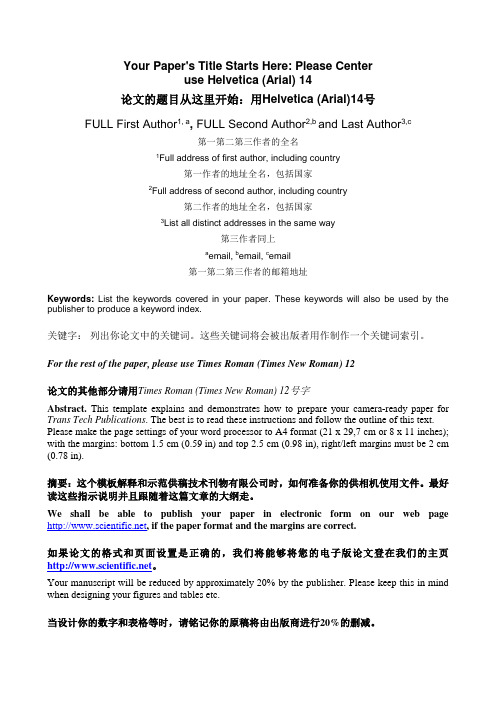
Your Paper's Title Starts Here: Please Centeruse Helvetica (Arial) 14论文的题目从这里开始:用Helvetica (Arial)14号FULL First Author1, a, FULL Second Author2,b and Last Author3,c第一第二第三作者的全名1Full address of first author, including country第一作者的地址全名,包括国家2Full address of second author, including country第二作者的地址全名,包括国家3List all distinct addresses in the same way第三作者同上a email,b email,c email第一第二第三作者的邮箱地址Keywords:List the keywords covered in your paper. These keywords will also be used by the publisher to produce a keyword index.关键字:列出你论文中的关键词。
这些关键词将会被出版者用作制作一个关键词索引。
For the rest of the paper, please use Times Roman (Times New Roman) 12论文的其他部分请用Times Roman (Times New Roman) 12号字Abstract. This template explains and demonstrates how to prepare your camera-ready paper for Trans Tech Publications. The best is to read these instructions and follow the outline of this text.Please make the page settings of your word processor to A4 format (21 x 29,7 cm or 8 x 11 inches); with the margins: bottom 1.5 cm (0.59 in) and top 2.5 cm (0.98 in), right/left margins must be 2 cm (0.78 in).摘要:这个模板解释和示范供稿技术刊物有限公司时,如何准备你的供相机使用文件。
中英文文献引用的标准格式
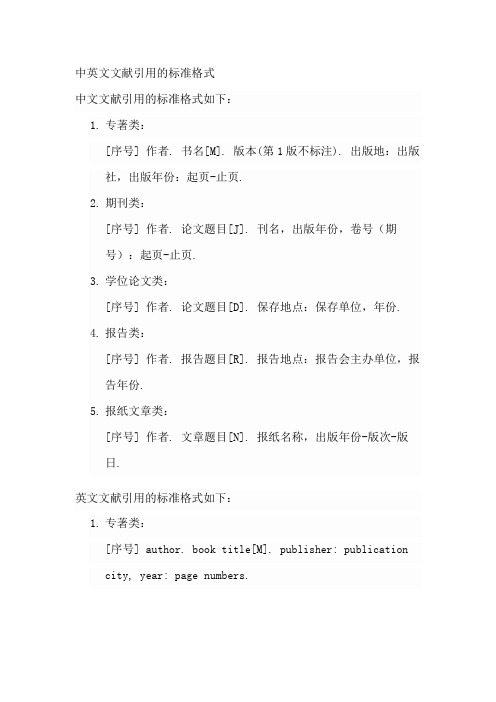
中英文文献引用的标准格式
中文文献引用的标准格式如下:
1.专著类:
[序号] 作者. 书名[M]. 版本(第1版不标注). 出版地:出版社,出版年份:起页-止页.
2.期刊类:
[序号] 作者. 论文题目[J]. 刊名,出版年份,卷号(期
号):起页-止页.
3.学位论文类:
[序号] 作者. 论文题目[D]. 保存地点:保存单位,年份.
4.报告类:
[序号] 作者. 报告题目[R]. 报告地点:报告会主办单位,报告年份.
5.报纸文章类:
[序号] 作者. 文章题目[N]. 报纸名称,出版年份-版次-版
日.
英文文献引用的标准格式如下:
1.专著类:
[序号] author. book title[M]. publisher: publication
city, year: page numbers.
2.期刊类:
[序号] author. article title[J]. journal title,
volume(issue): page numbers.
3.学位论文类:
[序号] author. thesis title[D]. location: institution name, year.
4.报告类:
[序号] author. report title[R]. location: report
organizer, year.
5.报纸文章类:
[序号] author. article title[N]. newspaper name, year-day-month.。
附录二 英文论文模板
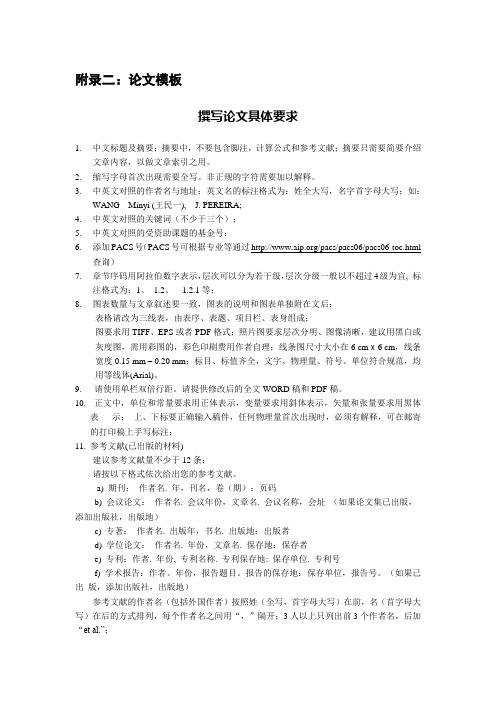
附录二:论文模板撰写论文具体要求1.中文标题及摘要;摘要中,不要包含脚注,计算公式和参考文献;摘要只需要简要介绍文章内容,以做文章索引之用。
2.缩写字母首次出现需要全写。
非正规的字符需要加以解释。
3.中英文对照的作者名与地址;英文名的标注格式为:姓全大写,名字首字母大写;如:WANG Minyi (王民一), J. PEREIRA;4.中英文对照的关键词(不少于三个);5.中英文对照的受资助课题的基金号;6.添加PACS号(PACS号可根据专业等通过/pacs/pacs06/pacs06-toc.html查询)7.章节序码用阿拉伯数字表示,层次可以分为若干级,层次分级一般以不超过4级为宜, 标注格式为:1、1.2、 1.2.1等;8.图表数量与文章叙述要一致,图表的说明和图表单独附在文后;表格请改为三线表,由表序、表题、项目栏、表身组成;图要求用TIFF、EPS或者PDF格式;照片图要求层次分明、图像清晰,建议用黑白或灰度图,需用彩图的,彩色印刷费用作者自理;线条图尺寸大小在6 cm x 6 cm,线条宽度0.15 mm – 0.20 mm;标目、标值齐全,文字、物理量、符号、单位符合规范,均用等线体(Arial)。
9.请使用单栏双倍行距。
请提供修改后的全文WORD稿和PDF稿。
10.正文中,单位和常量要求用正体表示,变量要求用斜体表示,矢量和张量要求用黑体表示;上、下标要正确输入稿件,任何物理量首次出现时,必须有解释,可在邮寄的打印稿上手写标注;11.参考文献(已出版的材料)建议参考文献量不少于12条;请按以下格式依次给出您的参考文献。
a) 期刊:作者名. 年,刊名,卷(期):页码b) 会议论文:作者名. 会议年份,文章名. 会议名称,会址(如果论文集已出版,添加出版社,出版地)c) 专著:作者名. 出版年,书名. 出版地:出版者d) 学位论文:作者名. 年份,文章名. 保存地:保存者e) 专利:作者. 年份, 专利名称. 专利保存地: 保存单位. 专利号f) 学术报告:作者。
中英文论文对照格式
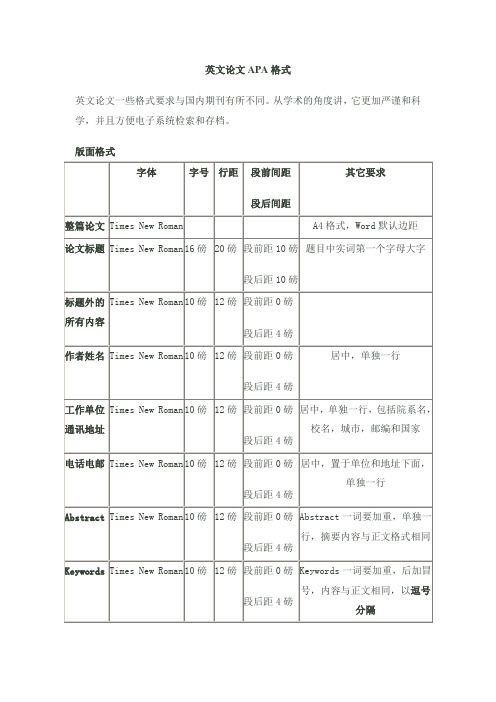
英文论文APA格式英文论文一些格式要求与国内期刊有所不同。
从学术的角度讲,它更加严谨和科学,并且方便电子系统检索和存档。
版面格式表格表格的题目格式与正文相同,靠左边,位于表格的上部。
题目前加Table后跟数字,表示此文的第几个表格。
表格主体居中,边框粗细采用0.5磅;表格内文字采用Times New Roman,10磅。
举例:Table 1. The capitals, assets and revenue in listed banks图表和图片图表和图片的题目格式与正文相同,位于图表和图片的下部。
题目前加Figure 后跟数字,表示此文的第几个图表。
图表及题目都居中。
只允许使用黑白图片和表格。
举例:Figure 1. The Trend of Economic Development注:Figure与Table都不要缩写。
引用格式与参考文献1. 在论文中的引用采取插入作者、年份和页数方式,如"Doe (2001, p.10) reported that …" or "This在论文中的引用采取作者和年份插入方式,如"Doe (2001, p.10) reported that …" or "This problem has been studied previously (Smith, 1958,pp.20-25)。
文中插入的引用应该与文末参考文献相对应。
举例:Frankly speaking, it is just a simulating one made by the government, or a fake competition, directly speaking. (Gao, 2003, p.220).2. 在文末参考文献中,姓前名后,姓与名之间以逗号分隔;如有两个作者,以and连接;如有三个或三个以上作者,前面的作者以逗号分隔,最后一个作者以and连接。
毕业设计论文外文文献翻译智能交通信号灯控制中英文对照
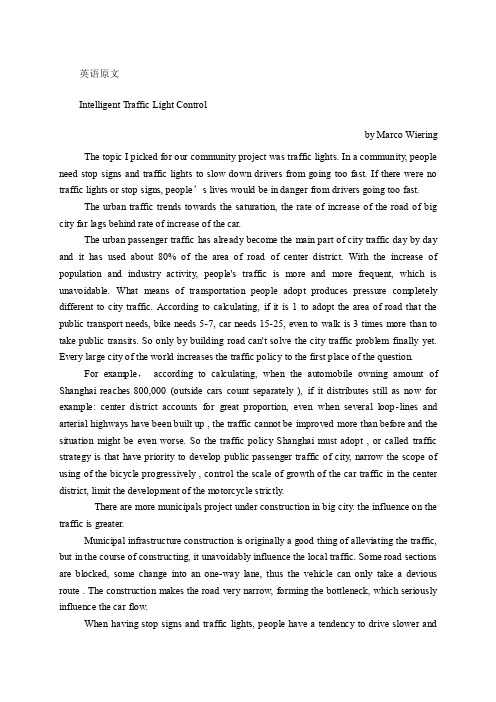
英语原文Intelligent Traffic Light Controlby Marco Wiering The topic I picked for our community project was traffic lights. In a community, people need stop signs and traffic lights to slow down drivers from going too fast. If there were no traffic lights or stop signs, people’s lives would be in danger from drivers going too fast.The urban traffic trends towards the saturation, the rate of increase of the road of big city far lags behind rate of increase of the car.The urban passenger traffic has already become the main part of city traffic day by day and it has used about 80% of the area of road of center district. With the increase of population and industry activity, people's traffic is more and more frequent, which is unavoidable. What means of transportation people adopt produces pressure completely different to city traffic. According to calculating, if it is 1 to adopt the area of road that the public transport needs, bike needs 5-7, car needs 15-25, even to walk is 3 times more than to take public transits. So only by building road can't solve the city traffic problem finally yet. Every large city of the world increases the traffic policy to the first place of the question.For example,according to calculating, when the automobile owning amount of Shanghai reaches 800,000 (outside cars count separately ), if it distributes still as now for example: center district accounts for great proportion, even when several loop-lines and arterial highways have been built up , the traffic cannot be improved more than before and the situation might be even worse. So the traffic policy Shanghai must adopt , or called traffic strategy is that have priority to develop public passenger traffic of city, narrow the scope of using of the bicycle progressively , control the scale of growth of the car traffic in the center district, limit the development of the motorcycle strictly.There are more municipals project under construction in big city. the influence on the traffic is greater.Municipal infrastructure construction is originally a good thing of alleviating the traffic, but in the course of constructing, it unavoidably influence the local traffic. Some road sections are blocked, some change into an one-way lane, thus the vehicle can only take a devious route . The construction makes the road very narrow, forming the bottleneck, which seriously influence the car flow.When having stop signs and traffic lights, people have a tendency to drive slower andlook out for people walking in the middle of streets. To put a traffic light or a stop sign in a community, it takes a lot of work and planning from the community and the city to put one in. It is not cheap to do it either. The community first needs to take a petition around to everyone in the community and have them sign so they can take it to the board when the next city council meeting is. A couple residents will present it to the board, and they will decide weather or not to put it in or not. If not put in a lot of residents might be mad and bad things could happened to that part of the city.When the planning of putting traffic lights and stop signs, you should look at the subdivision plan and figure out where all the buildings and schools are for the protection of students walking and riding home from school. In our plan that we have made, we will need traffic lights next to the school, so people will look out for the students going home. We will need a stop sign next to the park incase kids run out in the street. This will help the protection of the kids having fun. Will need a traffic light separating the mall and the store. This will be the busiest part of the town with people going to the mall and the store. And finally there will need to be a stop sign at the end of the streets so people don’t drive too fast and get in a big accident. If this is down everyone will be safe driving, walking, or riding their bikes.In putting in a traffic light, it takes a lot of planning and money to complete it. A traffic light cost around $40,000 to $125,000 and sometimes more depending on the location. If a business goes in and a traffic light needs to go in, the business or businesses will have to pay some money to pay for it to make sure everyone is safe going from and to that business. Also if there is too many accidents in one particular place in a city, a traffic light will go in to safe people from getting a severe accident and ending their life and maybe someone else’s.The reason I picked this part of our community development report was that traffic is a very important part of a city. If not for traffic lights and stop signs, people’s lives would be in danger every time they walked out their doors. People will be driving extremely fast and people will be hit just trying to have fun with their friends. So having traffic lights and stop signs this will prevent all this from happening.Traffic in a city is very much affected by traffic light controllers. When waiting for a traffic light, the driver looses time and the car uses fuel. Hence, reducing waiting times before traffic lights can save our European society billions of Euros annually. To make traffic light controllers more intelligent, we exploit the emergence of novel technologies such as communication networks and sensor networks, as well as the use of more sophisticated algorithms for setting traffic lights. Intelligent traffic light control does not only mean thattraffic lights are set in order to minimize waiting times of road users, but also that road users receive information about how to drive through a city in order to minimize their waiting times. This means that we are coping with a complex multi-agent system, where communication and coordination play essential roles. Our research has led to a novel system in which traffic light controllers and the behaviour of car drivers are optimized using machine-learning methods.Our idea of setting a traffic light is as follows. Suppose there are a number of cars with their destination address standing before a crossing. All cars communicate to the traffic light their specific place in the queue and their destination address. Now the traffic light has to decide which option (ie, which lanes are to be put on green) is optimal to minimize the long-term average waiting time until all cars have arrived at their destination address. The learning traffic light controllers solve this problem by estimating how long it would take for a car to arrive at its destination address (for which the car may need to pass many different traffic lights) when currently the light would be put on green, and how long it would take if the light would be put on red. The difference between the waiting time for red and the waiting time for green is the gain for the car. Now the traffic light controllers set the lights in such a way to maximize the average gain of all cars standing before the crossing. To estimate the waiting times, we use 'reinforcement learning' which keeps track of the waiting times of individual cars and uses a smart way to compute the long term average waiting times using dynamic programming algorithms. One nice feature is that the system is very fair; it never lets one car wait for a very long time, since then its gain of setting its own light to green becomes very large, and the optimal decision of the traffic light will set his light to green. Furthermore, since we estimate waiting times before traffic lights until the destination of the road user has been reached, the road user can use this information to choose to which next traffic light to go, thereby improving its driving behaviour through a city. Note that we solve the traffic light control problem by using a distributed multi-agent system, where cooperation and coordination are done by communication, learning, and voting mechanisms. To allow for green waves during extremely busy situations, we combine our algorithm with a special bucket algorithm which propagates gains from one traffic light to the next one, inducing stronger voting on the next traffic controller option.We have implemented the 'Green Light District', a traffic simulator in Java in which infrastructures can be edited easily by using the mouse, and different levels of road usage can be simulated. A large number of fixed and learning traffic light controllers have already been tested in the simulator and the resulting average waiting times of cars have been plotted and compared. The results indicate that the learning controllers can reduce average waiting timeswith at least 10% in semi-busy traffic situations, and even much more when high congestion of the traffic occurs.We are currently studying the behaviour of the learning traffic light controllers on many different infrastructures in our simulator. We are also planning to cooperate with other institutes and companies in the Netherlands to apply our system to real world traffic situations. For this, modern technologies such as communicating networks can be brought to use on a very large scale, making the necessary communication between road users and traffic lights possible.中文翻译:智能交通信号灯控制马克·威宁我所选择的社区项目主题是交通灯。
英语专业本科论文提纲(中英文对照)
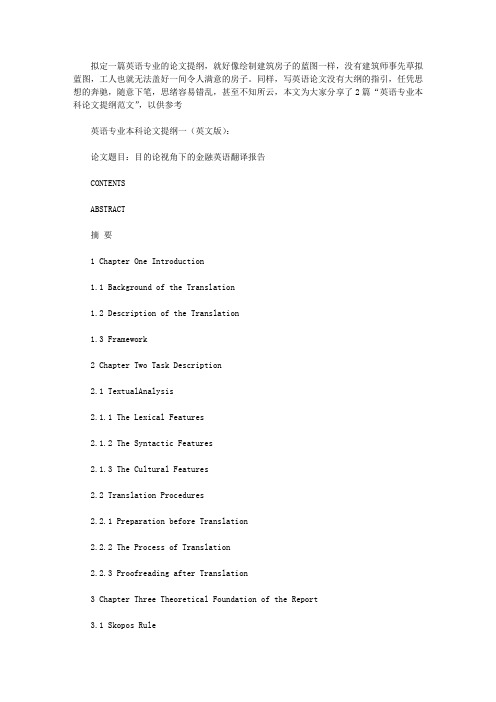
拟定一篇英语专业的论文提纲,就好像绘制建筑房子的蓝图一样,没有建筑师事先草拟蓝图,工人也就无法盖好一间令人满意的房子。
同样,写英语论文没有大纲的指引,任凭思想的奔驰,随意下笔,思绪容易错乱,甚至不知所云,本文为大家分享了2篇“英语专业本科论文提纲范文”,以供参考英语专业本科论文提纲一(英文版):论文题目:目的论视角下的金融英语翻译报告CONTENTSABSTRACT摘要1 Chapter One Introduction1.1 Background of the Translation1.2 Description of the Translation1.3 Framework2 Chapter Two Task Description2.1 TextualAnalysis2.1.1 The Lexical Features2.1.2 The Syntactic Features2.1.3 The Cultural Features2.2 Translation Procedures2.2.1 Preparation before Translation2.2.2 The Process of Translation2.2.3 Proofreading after Translation3 Chapter Three Theoretical Foundation of the Report3.1 Skopos Rule3.2 The Principle of Coherence3.3 The Principle of Fidelity4 Chapter Four CaseAnalysis4.1 Literal Translation Strategy4.1.1 The Reason of Using Literal Translation Strategy4.1.2 TheApplication of Literal Translation Strategy4.2 Contextual Translation Strategy4.2.1 The Reason of Using Contextual Translation Strategy 4.2.2 TheApplication of Contextual Translation Strategy4.3 Domesticating Translation Strategy4.3.1 The Reason of Using Domestication Translation Strategy4.3.2 TheApplication of Domesticating Translation Strategy5 Chapter Five Conclusion5.1 Summary5.2 Limitations and SuggestionsBIBLIOGRAPHYACKNOWLEDGEMENTSPUBLISHED PAPER英语专业本科论文提纲二(中文版):论文题目:《绝望的主妇》口译配音实证探讨目录摘要第一章绪论1.1研究动机1.2研究目的1.3研究范围1.4研究方法1.5论文结构第二章文献分析2.1关联理论的研究2.2口语背景的语言研究观2.3语意对等的口译观2.4口语口译研究第三章《绝望的主妇》语意关联成分探讨3.1情境喜剧《绝望的主妇》简介3.2人物特质和关联方式3.3言语关联语言分析3.4口译中的关联手法第四章《绝望的主妇》口译配音实证探讨4.1 口译合作原则4.2口译中的礼貌原则4.3口译言语行为准则研究4.3.1口语用语习惯4.3.2语法的正确表达4.3.3语意的精确表现4.3.4准确口译原文句子的意境第五章结论与建议5.1结论5.2研究应用5.3研究限制5.4未来研究方向参考文献致谢。
英文学术论文翻译-中英文对照(三)

•These new measures will, we believe, increase the people’s purchasing power and lead to thriving financial and commercial conditions rather than make a mess of the country’s finances as some people argue.
一、主谓单句
汉语的主谓单句,从外形结构 上来看,跟英语的“主谓”结构是 相似的,但它的主语和谓语表达却 与英语有许多不同的地方。所以翻 译汉语主谓单句时,至少应注意几 个问题。
1、防止主语的机械对应。 中国近几年来发生了巨变。 ①There have been great changes in China these years. ②These years have seen (witnessed) great changes in China. ③Great changes have taken place in China these years. ④China crackles with the dynamics of changes these years.
汉语的基本句型及其翻译
汉语造句以名词为重心,以词组、散句和 分句为手段,善于按时间、逻辑顺序进行横 排式叙述,有时断句不严,外形松散。有人 称汉语是时间型的动态结构,主要体现于形 式自由,富于弹性。
英语则以“主—谓”主干结构为重心来统 领各种语言成分,句界分明,外形严密。 因此,汉语各种句型译成英语时,不仅在 逻辑关系上而且在外形上都应该体现出英语 句法结构的特点。
2-3 Reversing • 1)沿路都是小商店。 Small shops dot the way. • 2)他这样悍然行事使我们非常气恼。 Hot anger burned in our minds against him at his rashness.
文章格式要求

论文格式要求一、总的要求全文一般不超过8000 汉字(约4000 英文单词),每篇论文均应有中英文两种文字的标题、作者、姓名、单位和不超过200 字的摘要。
全文电子邮件投稿,要求Word2003 兼容的电子文档和 PDF 文档各一份。
二、中文编排格式:大标题:居中,小二号,黑体,加粗,前空 1 行作者:居中,小四号,仿宋,与题目之间间隔0.5 行作者地址:五号,楷体,单倍行距中文摘要、关键词:小五号,楷体,与作者地址间隔 1 行,“摘要”和“关键词”加黑全文中出现的英文单词或字母一律采用Times New Roman 字体英文题目:居中,小二号,加黑,与前面中文“关键词”行间隔 1 行英文作者名:小四号,与英文题目之间间隔0.5 行英文作者地址:五号,单倍行距英文 Abstract 和 Keywords :小五号,斜体,与作者地址间隔 1 行,“Abstract ”和“ Keywords ”加黑正文:与前面的英文关键词间隔 1 行,正文内容的汉字用五号字,宋体一级标题:四号,黑体,加粗,前后空0.5 行二级标题:小四号,黑体,加粗三级标题:五号,黑体,加粗参考文献:小五号,宋体,具体请见参考文献编排格式,在正文中引用的汉语文献采用如下格式: [ 第一作者,年份] ,或者 [第一作者等,年份1,年份2] ,或者 [第一篇参考文献的第一作者,年份;第二篇参考文献的第一作者,年份,⋯ ];英文引用文献采用如下格式: [ 英文第一作者的姓,年份 ] ,或者 [英文第一作者姓 + et al.,年份 1,年份 2] 行距:单倍行距三、英文论文编排格式:字体: Times New Roman英文论文需有中文摘要大标题:居中,小二号,加粗作者名字、通信地址、中英文摘要、关键词等分别参照上面对应的说明正文:五号一级标题:四号,加粗二级标题:小四号,加粗三级标题:五号,加粗参考文献:小五号,具体请见参考文献编排格式行距:单倍行距四、参考文献编排格式:编号:参考文献前不要加编号排序:作者姓氏的发音顺序排列格式:专著:作者1,作者 2. 出版年份 . 书名 .出版社所在城市名:出版社,出版年.刊物:作者1,作者 2. 文章名 . 期刊名 . 发表年,卷或年(期):起讫页码 ..论文集:作者. 年份 . 文章名 . 论文集编者 . 论文集名 . 出版地:出版者,起讫页码翻译:原作者1,作者 2. 出版年份 . 书名 .译者名译 .出版社所在城市名:出版社外文第一作者姓在前,名字在后,姓与名中间用“,”分隔;除第一作者以外的姓名请按正常顺序书写五、模板:中英文模板请见下页引入标点处理的层次化汉语长句句法分析方法李幸宗成庆中国科学院自动化所模式识别国家重点实验室北京100080E-mail : {xli, cqzong}@摘要:在分析汉语标点符号用法和句法功能的基础上,本文提出了面向汉语长句的层次化句法分析方法。
中英文论文参考文献标准格式_论文格式_
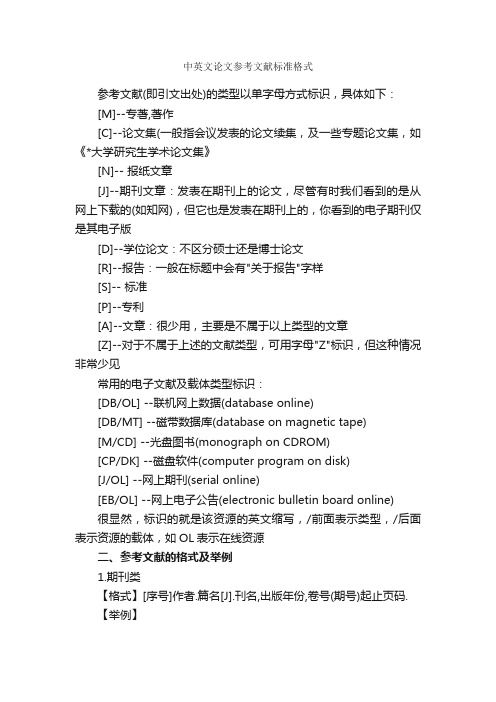
中英文论文参考文献标准格式参考文献(即引文出处)的类型以单字母方式标识,具体如下:[M]--专著,著作[C]--论文集(一般指会议发表的论文续集,及一些专题论文集,如《*大学研究生学术论文集》[N]-- 报纸文章[J]--期刊文章:发表在期刊上的论文,尽管有时我们看到的是从网上下载的(如知网),但它也是发表在期刊上的,你看到的电子期刊仅是其电子版[D]--学位论文:不区分硕士还是博士论文[R]--报告:一般在标题中会有"关于报告"字样[S]-- 标准[P]--专利[A]--文章:很少用,主要是不属于以上类型的文章[Z]--对于不属于上述的文献类型,可用字母"Z"标识,但这种情况非常少见常用的电子文献及载体类型标识:[DB/OL] --联机网上数据(database online)[DB/MT] --磁带数据库(database on magnetic tape)[M/CD] --光盘图书(monograph on CDROM)[CP/DK] --磁盘软件(computer program on disk)[J/OL] --网上期刊(serial online)[EB/OL] --网上电子公告(electronic bulletin board online)很显然,标识的就是该资源的英文缩写,/前面表示类型,/后面表示资源的载体,如OL表示在线资源二、参考文献的格式及举例1.期刊类【格式】[序号]作者.篇名[J].刊名,出版年份,卷号(期号)起止页码.【举例】[1] 周融,任志国,杨尚雷,厉星星.对新形势下毕业设计管理工作的思考与实践[J].电气电子教学学报,2019(6):107-109.[2] 夏鲁惠.高等学校毕业设计(论文)教学情况[J].高等理科教育,2019(1):46-52.[3] Heider, E.R.& D.C.Oliver. The structure of color space in naming and memory of two languages [J]. Foreign Language Teaching and Research, 1999, (3): 62 67.2.专著类【格式】[序号]作者.书名[M].出版地:出版社,出版年份:起止页码.【举例】[4] 刘国钧,王连成.图书馆史研究[M].北京:高等教育出版社,1979:15-18,31.[5] Gill, R. Mastering English Literature [M]. London: Macmillan, 1985: 42-45.3.报纸类【格式】[序号]作者.篇名[N].报纸名,出版日期(版次).【举例】[6] 李大伦.经济全球化的重要性[N]. 光明日报,1998-12-27(3).[7] French, W. Between Silences: A Voice from China[N]. Atlantic Weekly, 1987-8-15(33).4.论文集【格式】[序号]作者.篇名 [C].出版地:出版者,出版年份:起始页码.【举例】[8] 伍蠡甫.西方文论选[C]. 上海:上海译文出版社,1979:12-17.[9] Spivak,G. "Can the Subaltern Speak?"[A]. In C.Nelson & L. Grossberg(eds.). Victory in Limbo: Imigism [C]. Urbana: University of Illinois Press, 1988, pp.271-313.[10] Almarza, G.G. Student foreign language teacher's knowledge growth [A]. In D.Freeman and J.C.Richards (eds.). Teacher Learning in Language T eaching [C]. New York:Cambridge University Press. 1996. pp.50-78.5.学位论文【格式】[序号]作者.篇名[D].出版地:保存者,出版年份:起始页码.【举例】[11] 张筑生.微分半动力系统的不变集[D].北京:北京大学数学系数学研究所, 1983:1-7.6.研究报告【格式】[序号]作者. 篇名[R].出版地:出版者,出版年份:起始页码.【举例】[12] 冯西桥.核反应堆压力管道与压力容器的LBB分析[R].北京:清华大学核能技术设计研究院, 1997:9-10.7.专利【格式】[序号]专利所有者.题名[P].国别:专利号,发布日期.【举例】[13] 姜锡洲.一种温热外敷药制备方案[P].中国专利:881056073, 1989 07 26.8.标准【格式】[序号]标准编号,标准名称[S].【举例】[14] GB/T 16159-1996, 汉语拼音正词法基本规则 [S].9.条例【格式】[序号]颁布单位.条例名称.发布日期【举例】[15] 中华人民共和国科学技术委员会.科学技术期刊管理办法[Z].1991-06-0510.电子文献【格式】[序号]主要责任者.电子文献题名.电子文献出处[电子文献及载体类型标识].或可获得地址,发表或更新日期/引用日期.【举例】[17] 万锦.中国大学学报论文文摘(1983 1993).英文版 [DB/CD]. 北京: 中国大百科全书出版社, 1996.11.各种未定义类型的文献【格式】[序号] 主要责任者.文献题名[Z].出版地:出版者, 出版年.特别说明:凡出现在"参考文献"项中的标点符号都失去了其原有意义,且其中所有标点必须是半角,如果你的输入法中有半角/全解转换,则换到半角状态就可以了,如果你的输入法中没有这一转换功能,直接关闭中文输入法,在英文输入状态下输入即可.其实,很多输入法(如目前比较流行的搜狐输入法)都提供了四种组合:(1)中文标点+ 全角:这时输入的标点是这样的,:【1】-(而这时,我没有找到哪个键可以输入/ 符号)也就是说,这些符号是一定不能出现在"参考文献"中的;(2)中文标点+半角:这时输入的标点是这样的,:【1】-(这时,我还是没有找到哪个键可以输入/ 符号)也就是说,这些符号也不能出现在"参考文献"中的;上面列出的符号,中间没有任何的空格,你能看出它们有什么区别吗?我看只是-的宽度有一点点不同,其它都一样(3)英文标点+全角:这时输入的标点是这样的,.:[1]-/(4)英文标点+半角:这时输入的标点是这样的,.:[1]-/从这两项可以明显的看出,半角和全角其实最大的差别是所占的宽度不一样,这一点对于数字来说最为明显,而英文标点明显要比中文标点细小很多(也许因为英文中,标点的功能没有中文那么复杂,就是说英文中标点符号的能力没有中文那么强大)所以,很多人在写"参考文献" 时,总是觉得用英文标点+半角很不清楚,间距也太小,其实这点完全不用担心如果你觉得真的太小不好看,就用英文标点+全角吧而在[1] 之后,一般也都有一个空格更为详细的内容,大家可以从附件中下载国家标准《文后参考文献著录规则GB/T 7714-2019》查看,不过,很长很烦,拿出点耐心看吧对于英文参考文献,还应注意以下两点:①作者姓名采用"姓在前名在后"原则,具体格式是:姓,名字的首字母. 如: Malcolm Richard Cowley 应为:Cowley, M.R.,如果有两位作者,第一位作者方式不变,&之后第二位作者名字的首字母放在前面,姓放在后面,如:Frank Norris 与Irving Gordon应为:Norris, F. & I.Gordon.②书名、报刊名使用斜体字,如:Mastering English Literature,English Weekly.三、注释注释是对论文正文中某一特定内容的进一步解释或补充说明注释应置于本页页脚,前面用圈码①、②、③等标识。
中英文参考文献格式

中英文参考文献格式一、参考文献著录格式1 、期刊作者.题名〔J〕.刊名,出版年,卷(期)∶起止页码2、专著作者.书名〔M〕.版本(第一版不著录).出版地∶出版者,出版年∶起止页码3、论文集作者.题名〔C〕.编者.论文集名,出版地∶出版者,出版年∶起止页码4 、学位论文作者.题名〔D〕.保存地点.保存单位.年份5 、专利文献题名〔P〕.国别.专利文献种类.专利号.出版日期6、标准编号.标准名称〔S〕7、报纸作者.题名〔N〕.报纸名.出版日期(版次)8 、报告作者.题名〔R〕.保存地点.年份9 、电子文献作者.题名〔电子文献及载体类型标识〕.文献出处,日期二、文献类型及其标识1、根据GB3469 规定,各类常用文献标识如下:①期刊〔J〕②专著〔M〕③论文集〔C〕④学位论文〔D〕⑤专利〔P〕⑥标准〔S〕⑦报纸〔N〕⑧技术报告〔R〕2、电子文献载体类型用双字母标识,具体如下:①磁带〔MT〕②磁盘〔DK〕③光盘〔CD〕④联机网络〔OL〕3、电子文献载体类型的参考文献类型标识方法为:〔文献类型标识/载体类型标识〕。
例如:①联机网上数据库〔DB/OL〕②磁带数据库〔DB/MT〕③光盘图书〔M/CD〕④磁盘软件〔CP/DK〕⑤网上期刊〔J/OL〕⑥网上电子公告〔EB/OL〕三、举例1、期刊论文〔1〕周庆荣,张泽廷,朱美文,等.固体溶质在含夹带剂超临界流体中的溶解度〔J〕.化工学报,1995(3):317—323〔2〕Dobbs J M, Wong J M. Modification of supercritical fluid phasebehavior using polor coselvent〔J〕. Ind Eng Chem Res, 1987,26:56〔3〕刘仲能,金文清.合成医药中间体4-甲基咪唑的研究〔J〕.精细化工,2002(2):103-105 〔4〕 Mesquita A C, Mori M N, Vieira J M, et al .Vinyl acetate polymerization by ionizing radiation〔J〕.Radiation Physics and Chemistry,2002, 63:4652、专著〔1〕蒋挺大.亮聚糖〔M〕.北京:化学工业出版社,2001.127〔2〕Kortun G. Reflectance Spectroscopy 〔M〕. New York: Spring-Verlag,19693、论文集〔1〕郭宏,王熊,刘宗林.膜分离技术在大豆分离蛋白生产中综合利用的研究〔C〕.//余立新.第三届全国膜和膜过程学术报告会议论文集.北京:高教出版社,1999.421-425〔2〕Eiben A E, vander Hauw J K.Solving 3-SATwith adaptive genetic algorithms 〔C〕.//Proc 4th IEEE Conf Evolutionary Computation.Piscataway: IEEE Press, 1997.81-864、学位论文〔1〕陈金梅.氟石膏生产早强快硬水泥的试验研究(D).西安:西安建筑科学大学,2000 〔 2 〕Chrisstoffels L A J .Carrier-facilitated transport as a mechanistic tool in supramolecular chemistry〔D〕.The Netherland:Twente University.19885、专利文献〔1〕Hasegawa, Toshiyuki, Yoshida,et al.Paper Coating composition〔P〕.EP 0634524.1995-01-18〔 2 〕仲前昌夫,佐藤寿昭.感光性树脂〔 P 〕.日本,特开平09-26667.1997-01-28 〔3〕Yamaguchi K, Hayashi A.Plant growth promotor and productionthereof 〔P〕.Jpn, Jp1290606.1999-11-22〔4〕厦门大学.二烷氨基乙醇羧酸酯的制备方法〔P〕.中国发明专利,CN1073429.1993-06-23 6、技术标准文献〔1〕ISO 1210-1982,塑料——小试样接触火焰法测定塑料燃烧性〔S〕〔2〕GB 2410-80,透明塑料透光率及雾度实验方法〔S〕7、报纸〔1〕陈志平.减灾设计研究新动态〔N〕.科技日报,1997-12-12(5)8、报告〔1〕中国机械工程学会.密相气力输送技术〔R〕.北京:19969、电子文献〔1〕万锦柔.中国大学学报论文文摘(1983-1993)〔DB/CD〕.北京:中国百科全书出版社,1996英文参考文献英文文献采用“APA格式”:单一作者著作的书籍:姓,名字首字母.(年). 书名(斜体). 出版社所在城市:出版社.Sheril, R. D. (1956). The terrifying future: Contemplating color television. San Diego: Halstead.两位作者以上合著的书籍:姓,名字首字母., & 姓,名字首字母.(年). 书名(斜体). 出版社所在城市:出版社.Smith, J., & Peter, Q. (1992). Hairball: An intensive peek behind the surface of an enigma. Hamilton, ON: McMaster University Press.文集中的文章:Mcdonalds, A. (1993). Practical methods for the apprehension and sustained containment of supernatural entities. In G. L. Yeager (Ed.), Paranormal and occult studies: Case studies in application (pp. 42–64). London: OtherWorld Books.期刊中的文章(非连续页码):Crackton, P. (1987). The Loonie: God's long-awaited gift to colourful pocket change? Canadian Change, 64(7), 34–37.期刊中的文章(连续页码):姓,名字首字母.(年). 题目. 期刊名(斜体). 第几期,页码.Rottweiler, F. T., & Beauchemin, J. L. (1987). Detroit and Narnia: Two foes on the brink of destruction. Canadian/American Studies Journal, 54, 66–146.月刊杂志中的文章:Henry, W. A., III. (1990, April 9). Making the grade in today's schools. Time, 135, 28-31.。
- 1、下载文档前请自行甄别文档内容的完整性,平台不提供额外的编辑、内容补充、找答案等附加服务。
- 2、"仅部分预览"的文档,不可在线预览部分如存在完整性等问题,可反馈申请退款(可完整预览的文档不适用该条件!)。
- 3、如文档侵犯您的权益,请联系客服反馈,我们会尽快为您处理(人工客服工作时间:9:00-18:30)。
英文论文APA格式英文论文一些格式要求与国内期刊有所不同。
从学术的角度讲,它更加严谨和科学,并且方便电子系统检索和存档。
版面格式表格表格的题目格式与正文相同,靠左边,位于表格的上部。
题目前加Table后跟数字,表示此文的第几个表格。
表格主体居中,边框粗细采用0.5磅;表格内文字采用Times New Roman,10磅。
举例:Table 1. The capitals, assets and revenue in listed banks图表和图片图表和图片的题目格式与正文相同,位于图表和图片的下部。
题目前加Figure 后跟数字,表示此文的第几个图表。
图表及题目都居中。
只允许使用黑白图片和表格。
举例:Figure 1. The Trend of Economic Development注:Figure与Table都不要缩写。
引用格式与参考文献1. 在论文中的引用采取插入作者、年份和页数方式,如"Doe (2001, p.10) reported that …" or "This在论文中的引用采取作者和年份插入方式,如"Doe (2001, p.10) reported that …" or "This problem has been studied previously (Smith, 1958,pp.20-25)。
文中插入的引用应该与文末参考文献相对应。
举例:Frankly speaking, it is just a simulating one made by the government, or a fake competition, directly speaking. (Gao, 2003, p.220).2. 在文末参考文献中,姓前名后,姓与名之间以逗号分隔;如有两个作者,以and连接;如有三个或三个以上作者,前面的作者以逗号分隔,最后一个作者以and连接。
3. 参考文献中各项目以“点”分隔,最后以“点”结束。
4. 文末参考文献请按照以下格式:a). 如果文献是图书,书名使用斜体。
如果是文献是书中的一篇文章,请参考举例(2)举例: (1)Strunk, W., Jr., & White, E. B. (1979). The elements of style. (3rd ed.). New York: Macmillan, (Chapter 4).(2) Mettam, G. R., & Adams, L. B. (1994). How to prepare an electronic versionof your article. In B. S. Jones, & R. Z. Smith (Eds.), Introduction to the electronic age. New York: E-Publishing Inc. pp. 281-304b). 如果文献是期刊或报刊中的文章,文章名加引号,期刊报刊名不需要加引号,期刊举例:Van der Geer, J., Hanraads, J. A. J., & Lupton R. A. (2000). The art of writing a scientific article. Journal of Scientific Communications, 163, 51-59报纸举例:Smith, Joe. (2005). 3G Economy, Whose Economy: Report of 3G Century. Report of 21st Century Economy. 20 January 2005.c). 如果文献是网页,请尽量包括作者,年份,题目,网址和检索的时间。
举例:Smith, Joe. (1999). One of Volvo's core values. [Online] Available:/environment/index.htm (July 7, 1999)常见问题和错误1. 在英文论文中,一定不要出现汉字和中文字符。
如果出现,会在英文排版系统中出现乱码。
2. 一些标点中文和英文看上去相似,但在系统中却不一样,请注意不要在中文输入状态下输入这个标点:逗号,引号,冒号,句号,横杠,顿号,括号。
3. 为防止出现中文字符,英文论文完成后,请使用Word中“字数统计”功能查询,“中文字符朝鲜语单词”一项应该为“0”,如果不为0,表示英文翻译中存在中文字符,请检查修改。
4.工作单位的翻译首先到单位的网站查询英文名,当然所在单位若有自己的通用译法,按照通用的即可。
一定要保证发表出来的单位译法科研处认可啊。
毕业论文撰写手册一、论文撰写的目的毕业论文是高职高专大学生专科学业要求的一部分,目的是使学生在教师的指导下,通过进行文献检索、资料整理、问题分析、论文写作等活动,初步掌握科研的基本方法和学术论文的写作方法、培养独立进行科学研究和英文写作的能力。
二、毕业论文的基本要求专科毕业论文要求学生对英美文学、英语语言学或商务英语领域中的某一方面有全面的了解,对某一问题进行归纳分析,并用英语正确得体的表述和论证,表明自己的确已经较好的掌握本专业的基础理论专业知识和基本技能,并具有从事英语或商务英语翻译工作或实际工作的初步能力。
毕业论文应在老师指下由学生本人独立完成。
专科毕业论文正文部分应不少于3000字,不超过4000字,引文不超过论文正文的30%。
论文写作的参考文献应不少于10本或(篇)。
论文用A4复印纸打印,正文用宋体小4号字,标题用楷体3号字,三、撰写的步骤与方法专科论文的写作一般由选题文献检索与资料整理撰写提纲起草论文教师批改修改定稿等步骤组成。
具体做法是(一)选题撰写论文的第一步就是确定一个恰当的题目,然后围绕选题进行其他各项工作。
在各自导师的指导下进行选题。
选题共分三个方向,即:英美文学、英语语言学和英汉翻译学。
附录1提供了三个方向的部分参考选题,考生可从中选择,也可根据自己的实际情况另选题目。
1.选题原则应根据自己的所学专业来确定;避免选择过偏、过窄、过于生僻的题目。
2.选题注意事项选题应该有意义,有新意,观点正确、明确;选题应在个人能力可及范围之内;确定选题之前,对该选题所涉及的资料有充分的了解;通过对该选题论证和分析,能得出较客观公正的结论。
3.文献检索与资料整理文献检索与资料整理是论文写作过程中非常重要而又经常被人们忽视的环节。
只有掌握了有关题目的相关资料,了解其研究现状和最新成果,才有可能找到合理恰当的切入点。
因此,在论文写作初期要着力搜集与选题相关的资料,边搜集、边阅读、边整理。
搜集整理资料的过程就是研究的过程,也是形成自己的观点的过程。
只有吃透了别人的观点,才能发现字观点与别人的异同,才能提出自己独特的建树。
4.拟订提纲在对资料进行整理分析的基础上,逐步形成自己的观点,然后根据逻辑关系对这些论点,论据,素材进行整理,构思论文的框架,明确论文的层次,拟就论文提纲。
提纲要提交指导教师提出修改意见,经指导教师许可后,考生即可动笔写作。
5.起草论文论文的起草必须由考生独立完成,不准找人代笔,不准抄袭他人作品或照搬他人观点。
论文应层次分明、论点突出,论述充分。
考生应在规定的最后期限前将初稿与指导教师批阅。
6.教师批改指导教师对学生的论文初稿要进行认真细致的审阅,要检查论文格式是否符合要求、观点是否正确、论述是否清楚、语言是否通顺。
指导教师要从以上几个方面对论文初稿提出具体修改意见并返还给学生。
7.论文的修改与定稿考生在收到指导教师的修改意见后应对论文进行认真地修改,对老师提出的问题要逐一改正,然后在规定时间内交外语翻译学院论文办公室。
四、论文的构成与格式河北省高等教育英语专业专科毕业论文由八部分组成,即:中文封面、英文封面、中英文摘要、中英文关键词、目录、正文、注释、参考书目,等。
各部分的内容和格式如下:1.中文封面(见第4页的样本,可直接用。
)中文封面包括论文题目、论文作者、指导教师姓名和职称、论文完成日期等。
论文题目应能概括整个论文最重要的内容,简明、恰当、引人注目。
题目应力求简短,一般不超过15—20字。
必要时可以使用副标题。
具体格式见附录2:论文中文格式样本。
2.英文封面(见第5页的样本,可直接用。
)论文第二页为英文封面页。
英文封面与中文封面内容基本一致,但格式略有不同。
论文要翻译得体,各部分位置参见附录2:英文封面格式样本。
3.中英文内容摘要论文第三页为中文内容摘要,中文摘要一般在200—300字左右,应用说明本论文的研究方法、主要观点和内容。
语言力求精炼、准确。
摘要(小三号黑体)内容XXXXXXXXXX(小四宋体)关键词:XXX;XXX;XXX;(小三号黑体,中间用空格隔开)英文摘要为论文的第四页,内容与字数与中文摘要相同,中英文摘要的格式分别参见附录2中文摘要内容及关键词格式样本和英文内容摘要及关键词格式样本。
题目(times new roman三号字体)摘要(times new roman小三字体)内容:XXXXXXXXX (times new roman小四字体)关键词:XXX;XX;XX;( times new roman小三字体,关键词中间用空格隔开)4.中英文关键词关键词应当是最能反映论文观点的术语或者是论文中使用频率最高的词语,一般为3—5个。
中英文关键词分别在中英文内容摘要页的最下方另起一行注明。
关键词间无标点符号,但要空两格。
关键词格式可参见附录2:中文摘要内容及关键词格式样本和附录2英文内容摘要及关键词格式样本。
5.目录目录由论文文章节编号、论文二级标题和三级标题及其出现的页码组成。
目录应另页排在论文正文之前。
格式见附录2:论文目录格式样本。
6.正文正文一般由三部分组成,即:引言、主体和结论。
引言应当简述一下论文所涉及领域的研究现状,介绍论文的意义及价值,引出论文的切入点,概述论文的结构等。
主体是论文的论述部分。
由于论文较长,内容较多,一般分章节。
章节应用小标题,同级的标题应尽可能保持结构、内容和长短的一致。
结论是对整个论文的总结和概括。
结论中除对本论文核心观点进行强调外,也可指出研究中遗留的问题或有待进一步研究的问题。
引言和结论一般不列入主体章节中。
正文全部用Times New Roman字体14号,章节标题24号加粗居中,小标题18号左对齐。
页面设置(1)页眉:1.5厘米;(2)摘要页码用:I、II、III……,正文页码用阿拉伯数字1、2、3、……,页码居中;(3)字间距:标准;(4)行间距:固定值,20磅;(5)页边距:上2.8厘米,下2.5厘米,左3厘米(含装订线0.5厘米),右2.5厘米;7. 注释论文引用别人的材料,要注明出处。
